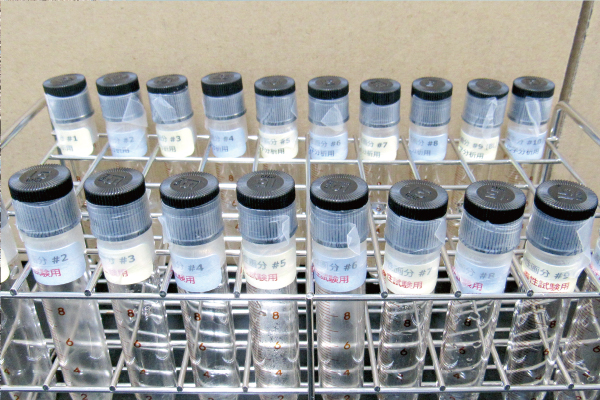Environmental Chemistry Lab, Department of Applied Chemistry,
Faculty of Science and Technology, Keio University
Led by Tomoaki OKUDA, Ph.D.
Research
Home > Research > Highlights [Particle Charging State]
Highlights
- Toxicity Assessment of Particulate Matter
- Worldwide Application of Our Environmental Research
- Particle Charging State
- Environmental Issues in Subway Stations and Enclosed Spaces
- Super Practical Human and Environmental Research enforcing Application and Social Implementation
Particle Charging State
Atmospheric aerosol particles deposit on the surfaces of human airways, resulting in adverse health effects. Specifically, the number of charged particles deposited on the surface of the human airway increases with the charge number, as demonstrated by previous experimental and theoretical studies. In order to answer the question, "How much do atmospheric aerosol particles deposit on the human airways ?", it is crucial to accurately measure the charging state of particles in the atmosphere and elucidate the mechanisms underlying the generation of charged particles. However, few studies have examined changes in the charge distribution of submicron atmospheric particles. Our goal is to elucidate the mechanisms of the charging state of submicron atmospheric particles and their impact on the human body, climate change, and industries, by measuring the particle charge distribution through the development of novel measurement techniques.
Experiment and Observation Studies to Elucidate Factors Affecting the Changes in Charge Distribution of Submicron Atmospheric Particles
Our goal is to elucidate the charging mechanisms of submicron atmospheric particles. To achieve this, we have applied our independently developed “K-MACS (Keio Measurement system of Aerosol Charging State)” to experiments and atmospheric observations (Fig. 1). We estimated the charge distribution of particles by measuring the positively charged, non-charged, and negatively charged particles using a combination of K-MACS and four optical particle counters (OPCs). The K-MACS was developed in collaboration with technical staff at the Mechanical Engineering Common Laboratory (Manufacturing Center) of our university.
Snap Shots
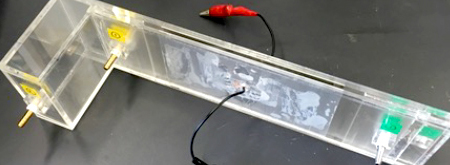 The K-MACS, which was developed independently in our laboratory. It is a device that separates atmospheric aerosols introduced between voltage-applied copper plates into positively charged particles, negatively charged particles, and non-charged particles. This device was selected as one of the Top 10 Most Downloaded Articles in Aerosol Science & Technology for two consecutive months. It was also featured in “KEIO RESEARCH HIGHLIGHTS,” which showcases research across Keio University.
The K-MACS, which was developed independently in our laboratory. It is a device that separates atmospheric aerosols introduced between voltage-applied copper plates into positively charged particles, negatively charged particles, and non-charged particles. This device was selected as one of the Top 10 Most Downloaded Articles in Aerosol Science & Technology for two consecutive months. It was also featured in “KEIO RESEARCH HIGHLIGHTS,” which showcases research across Keio University.
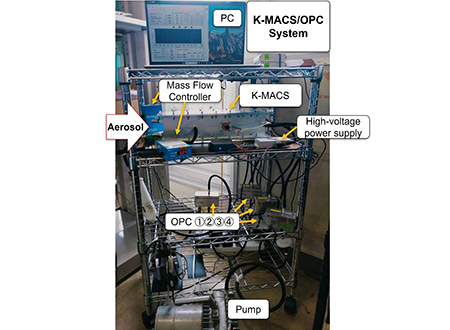 System for measuring the charge distribution of submicron atmospheric particles with a particle size range of 0.3–0.5 µm at a high time resolution.
System for measuring the charge distribution of submicron atmospheric particles with a particle size range of 0.3–0.5 µm at a high time resolution.
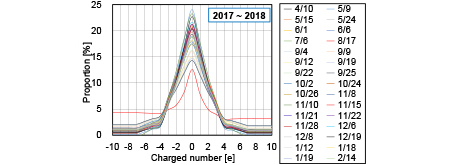 Seasonal patterns of the charge distribution of submicron atmospheric particles in Yokohama (2023) and Noto (2024) during (a) summer and (b) winter (Mori et al., 2025).
Seasonal patterns of the charge distribution of submicron atmospheric particles in Yokohama (2023) and Noto (2024) during (a) summer and (b) winter (Mori et al., 2025).
Estimating the Charge Number of Individual Particles in the Atmosphere Using a Kelvin Probe Force Microscopy
The degree of inflammation that occurs when particles are deposited in the human airways depends heavily on the chemical species of the particles, such as ammonium sulfate and black carbon. In our laboratory, we developed a method to investigate the charging state and chemical species of individual particles (Shinke et al., 2023) by measuring the surface potential of particles using Kelvin Probe Force Microscopy (KPFM) and identifying their chemical species using Scanning Electron Microscopy/Energy Dispersive X-ray spectroscopy (SEM/EDX). By collecting the particles from the atmosphere using an impactor, we aim to clarify “which chemical species of aerosols are charged and to what extent?”.
Snap Shots
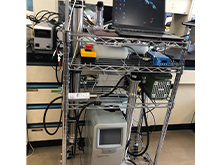 (a) KPFM and (b) SEM/EDX equipment located at our university. KPFM was used by attaching a dedicated KPFM module (owned by our laboratory) to a standard Atomic Force Microscopy (AFM) system.
(a) KPFM and (b) SEM/EDX equipment located at our university. KPFM was used by attaching a dedicated KPFM module (owned by our laboratory) to a standard Atomic Force Microscopy (AFM) system.
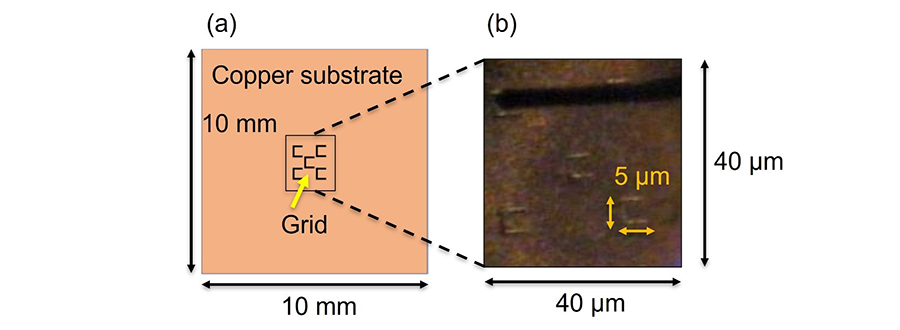 (a): Image of a grid on the copper substrate. The same particles can be found using different microscopes, such as KPFM and SEM/EDX. (b) A photograph of the grid on the copper substrate.
(a): Image of a grid on the copper substrate. The same particles can be found using different microscopes, such as KPFM and SEM/EDX. (b) A photograph of the grid on the copper substrate.
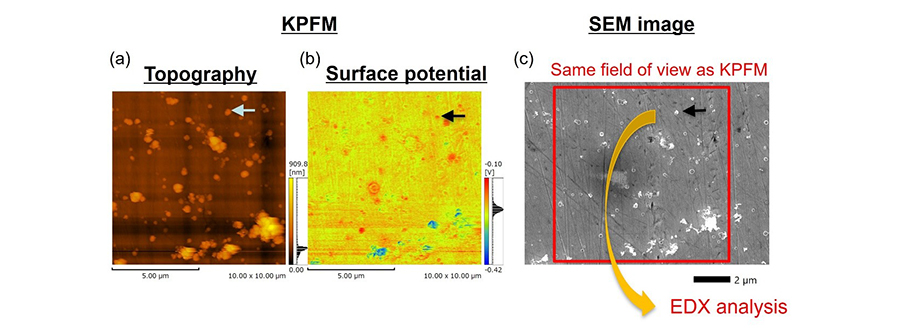 Examples of (a) topography and (b) surface potential maps of particles collected in Yokohama, Japan as analyzed by KPFM, and (c) electron micrograph as analyzed by SEM. The red frame represents the same field of view as the KPFM image, and the particles indicated by the arrows are the same particles. The chemical composition of the individual particles was identified using EDX analysis.
Examples of (a) topography and (b) surface potential maps of particles collected in Yokohama, Japan as analyzed by KPFM, and (c) electron micrograph as analyzed by SEM. The red frame represents the same field of view as the KPFM image, and the particles indicated by the arrows are the same particles. The chemical composition of the individual particles was identified using EDX analysis.
Clarificatioin of Chemical Composition of Multiple Charged Aerosols
In environments with significant changes in atmospheric electric fields (such as strong winds or lightning) or near emission sources, multivalent ions easily attach to or collide with ambient aerosols, generating multiple charged particles. To clarify the mechanism for generating the multiple charged particles, it is critically important to quantitaively understand how they behave in the atmosphere. In our laboratory, we have developed a device that collects only charged particles in the atmosphere onto filters by applying a high voltage. By analyzing these filters using SEM/EDX and Energy Dispersive X-Ray Fluorescence (EDXRF) analysis, we aim to clarify the relationship between multiple charged particles and their corresponding chemical species.
Snap Shots
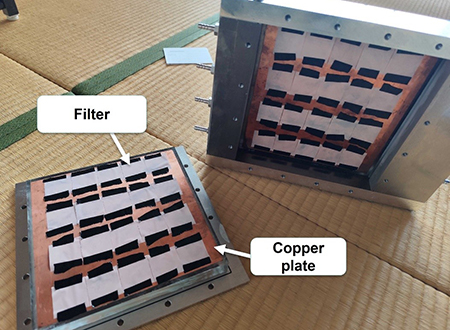 Polycarbonate filters attached to a copper plate. These filters were analyzed using SEM/EDX and EDXRF.
Polycarbonate filters attached to a copper plate. These filters were analyzed using SEM/EDX and EDXRF.
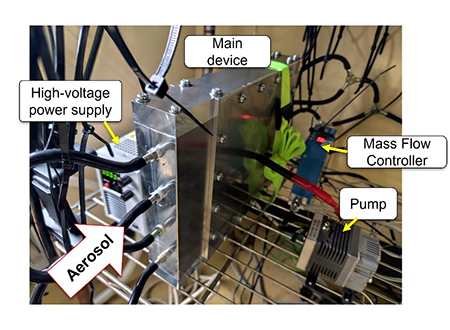 A collection system of charged particles installed in Noto, Japan
A collection system of charged particles installed in Noto, Japan
Research
Vision
Research Topics
Publications
Research Grants


